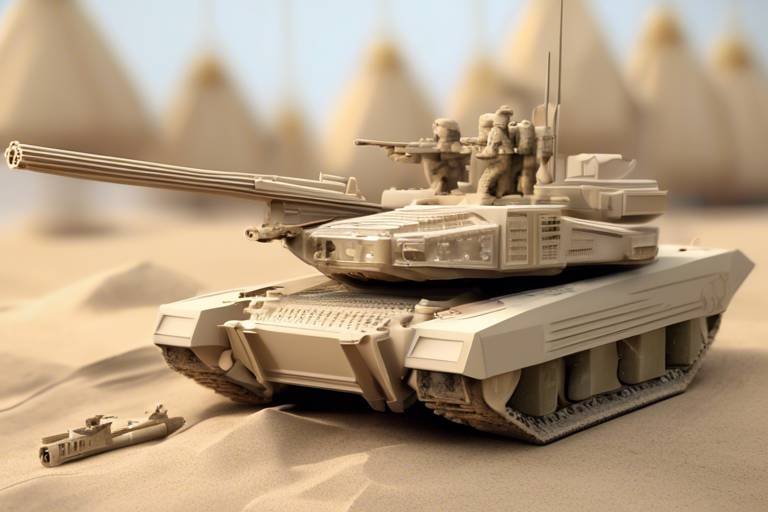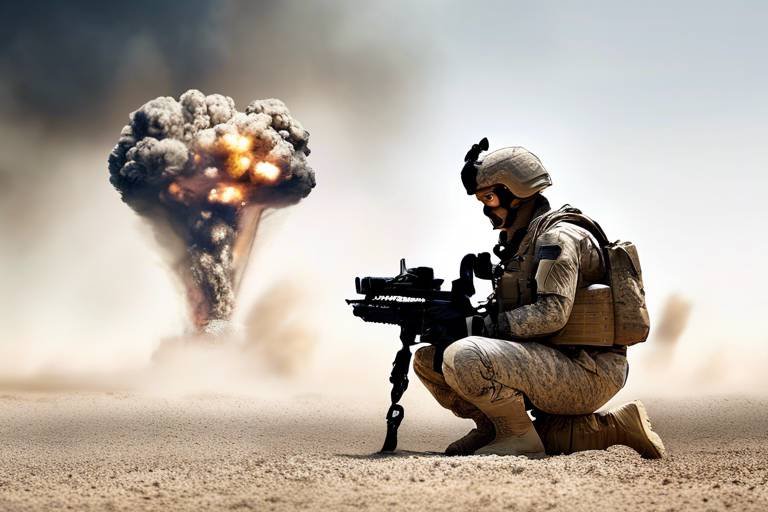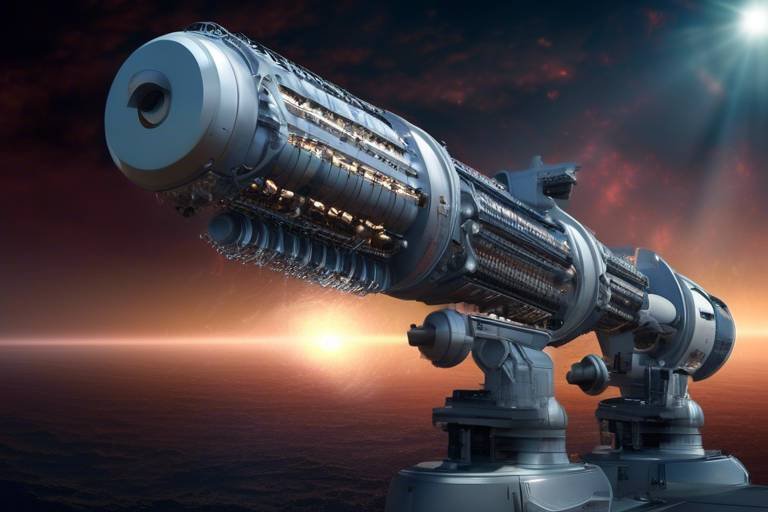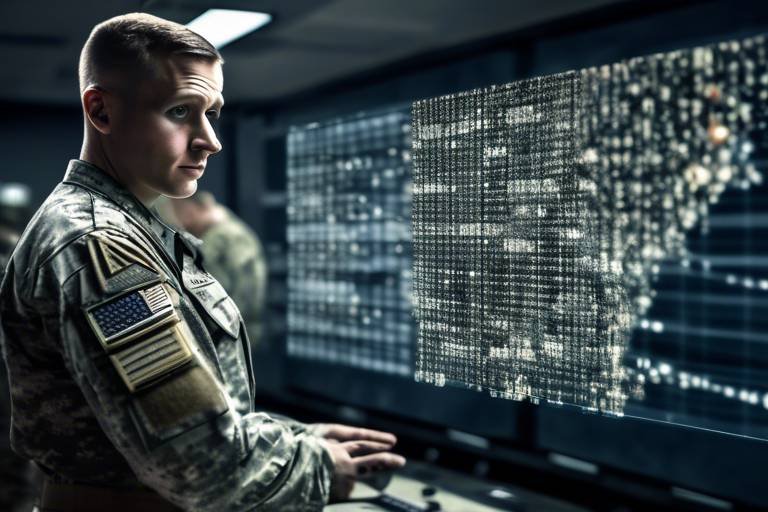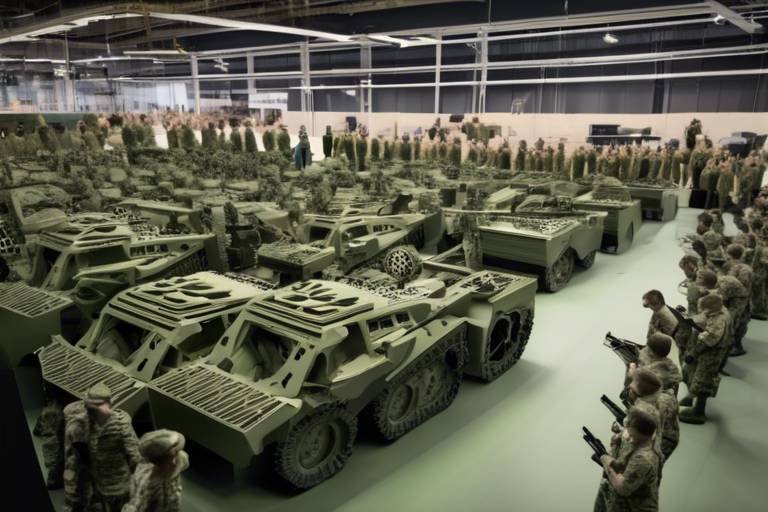Top 10 Breakthroughs in Military Technology in the Last Decade
The past decade has witnessed a remarkable transformation in military technology, driven by rapid advancements in various fields. These breakthroughs have not only enhanced the capabilities of armed forces but have also fundamentally changed the nature of warfare. From autonomous systems to cyber warfare tactics, the innovations discussed in this article highlight how technology has reshaped strategic operations globally. As we delve into these developments, it's essential to understand their implications on both modern combat and international security.
The rise of autonomous weapons systems has revolutionized combat strategies, enabling machines to make decisions on the battlefield. Imagine a scenario where drones and robots can assess threats and engage targets without human intervention. This not only reduces the risk to soldiers but also increases operational efficiency. Countries are investing heavily in these technologies, aiming to create systems that can operate independently in complex environments. However, this raises ethical questions about accountability and the potential for unintended consequences in warfare.
In today's digital age, cyber warfare has emerged as a critical front in military operations. Nations are developing sophisticated tactics to protect their infrastructure from cyber attacks and disrupt adversaries through digital means. This new battleground is characterized by stealth and precision, where the lines between offense and defense have blurred. Cyber operations can range from disabling critical infrastructure to stealing sensitive information, making it essential for military organizations to invest in robust cybersecurity measures.
Innovations in surveillance technologies, including drones and satellite systems, have significantly enhanced reconnaissance capabilities. These tools allow for real-time intelligence gathering, providing military leaders with improved situational awareness in conflict zones. For instance, drones equipped with high-resolution cameras and sensors can monitor enemy movements without putting personnel at risk. This capability has transformed how military operations are planned and executed, enabling forces to respond swiftly to emerging threats.
Directed energy weapons, such as lasers, are changing the landscape of defense systems. These weapons offer precise targeting and significantly reduce collateral damage, making them an attractive alternative to traditional munitions. Imagine a scenario where a military base can defend itself against incoming missiles using a laser system that can engage targets with pinpoint accuracy. Not only does this enhance safety for civilians, but it also provides a cost-effective solution for modern defense needs.
The development of enhanced soldier systems integrates advanced materials, wearable technology, and communication tools to improve individual performance and safety on the battlefield. Picture soldiers equipped with exoskeletons that amplify their strength and endurance, or smart helmets that provide real-time data and communication capabilities. These innovations are designed to enhance the effectiveness of troops while ensuring their safety in high-risk environments.
Artificial intelligence (AI) is transforming military operations by enabling data analysis, predictive modeling, and decision-making processes. AI systems can process vast amounts of information quickly, allowing military planners to make informed decisions based on real-time data. For example, AI can analyze battlefield conditions and predict enemy movements, providing a strategic advantage. As AI continues to evolve, its integration into military applications will likely lead to more efficient and effective operations.
Hypersonic missiles represent a significant leap in missile technology, capable of traveling at speeds exceeding Mach 5. This incredible speed makes them difficult to detect and intercept, fundamentally altering deterrence strategies. Countries are racing to develop these advanced weapons, which can strike targets with little warning, posing new challenges for missile defense systems worldwide. The introduction of hypersonic technology is reshaping global military balance and strategic planning.
3D printing technology is being utilized in defense to produce spare parts and equipment on-demand. This innovation reduces supply chain vulnerabilities and enables rapid response in critical situations. Imagine a military unit in a remote location being able to print replacement parts for their equipment instead of waiting weeks for delivery. This capability not only enhances operational readiness but also significantly cuts costs associated with traditional manufacturing and logistics.
Quantum computing is poised to revolutionize military cryptography, providing unprecedented encryption capabilities that enhance data security. As military operations increasingly rely on digital communication, the need for robust encryption becomes paramount. Quantum computers can solve complex problems much faster than traditional computers, making them invaluable for securing sensitive information from adversaries. This technological leap could redefine how militaries protect their data in an age where cyber threats are ever-present.
- What are autonomous weapons systems?
These are military systems that can operate independently, making decisions on the battlefield without human intervention. - How has cyber warfare changed military operations?
Cyber warfare has introduced a new front in military operations, focusing on digital attacks and defense strategies. - What role does artificial intelligence play in modern warfare?
AI enhances data analysis, predictive modeling, and decision-making processes, improving the effectiveness of military strategies.

1. Autonomous Weapons Systems
The emergence of autonomous weapons systems marks a pivotal shift in modern warfare, redefining how conflicts are fought and altering the very fabric of military strategy. Imagine a battlefield where machines, equipped with advanced algorithms, make real-time decisions without human intervention. This isn't science fiction; it's the reality of today's military technology. These systems are designed to identify, engage, and neutralize threats with remarkable precision, which not only enhances operational efficiency but also significantly reduces the risk to human soldiers.
One of the most compelling aspects of autonomous weapons is their ability to process vast amounts of data at lightning speed. This capability enables them to assess situations and respond to threats much faster than a human could. For example, in high-stakes environments where every second counts, these systems can analyze incoming data from various sensors, make split-second decisions, and act accordingly, all while minimizing the potential for human error. As a result, the tactical advantage they offer is immense, potentially turning the tide in favor of those who deploy them effectively.
However, the rise of these systems is not without controversy. Ethical concerns surrounding their use are at the forefront of discussions about the future of warfare. Questions arise about accountability—if an autonomous system makes a mistake, who is responsible? The implications of allowing machines to make life-and-death decisions are profound and troubling. Moreover, there are fears that such technology could lower the threshold for conflict, making it easier for nations to engage in warfare since human soldiers are not directly at risk.
To illustrate the technological advancements in this field, consider the following table that highlights key features of various autonomous weapons systems currently in development:
| System Name | Type | Capabilities | Status |
|---|---|---|---|
| MQ-9 Reaper | Drone | Surveillance, precision strikes | Operational |
| RoboBee | Micro-drone | Pollination, surveillance | In development |
| MAARS | Ground robot | Reconnaissance, support | Operational |
| Sea Hunter | Naval drone | Anti-submarine warfare | Operational |
As nations continue to invest in research and development of autonomous weapons systems, the landscape of military engagement will undoubtedly evolve. The potential for increased efficiency and reduced human casualties is enticing, yet the ethical dilemmas and risks associated with these technologies cannot be ignored. Balancing innovation with responsibility will be crucial as we navigate this new frontier in military capabilities.
- What are autonomous weapons systems? Autonomous weapons systems are military technologies that can operate without human intervention, making decisions based on pre-programmed algorithms and real-time data.
- How do these systems improve military operations? They enhance operational efficiency, reduce human risk, and can process data faster than humans, allowing for quicker decision-making in combat situations.
- What are the ethical concerns surrounding their use? Key concerns include accountability for mistakes, the potential for lowering the threshold for conflict, and the moral implications of machines making life-and-death decisions.

2. Cyber Warfare Tactics
The digital battlefield has become as crucial as the physical one, with cyber warfare emerging as a game-changing component of military strategy. In the last decade, nations have recognized that the ability to protect and disrupt digital infrastructures can be just as impactful as traditional military might. Imagine a battlefield where the enemy is not just in front of you but lurking in the wires and codes of your technology—this is the reality of modern warfare.
Cyber warfare tactics have evolved significantly, utilizing advanced technologies and strategies to gain an upper hand. Governments and military organizations are now employing cyber espionage, cyber attacks, and defensive measures to safeguard their interests and undermine those of their adversaries. For instance, the use of sophisticated malware to infiltrate enemy systems can lead to the theft of sensitive information or even the disruption of critical services. The 2016 U.S. presidential election hacking incident is a prime example of how cyber tactics can influence national security.
Moreover, nations have developed cyber defense strategies that include real-time monitoring and rapid response teams to counteract potential threats. These strategies often involve:
- Threat Intelligence: Gathering and analyzing data to predict and prevent cyber attacks.
- Incident Response: Having teams ready to react quickly when a breach occurs.
- Public-Private Partnerships: Collaborating with tech companies to enhance cybersecurity measures.
As the tactics evolve, so do the tools. The development of artificial intelligence plays a significant role in enhancing cyber warfare capabilities. AI can analyze vast amounts of data to identify vulnerabilities and predict potential attacks before they happen. This proactive approach is essential in a landscape where the speed of response can determine the outcome of an engagement.
Another fascinating aspect of cyber warfare tactics is the concept of information warfare. This involves the strategic use of information to influence public opinion and destabilize adversaries. Social media platforms have become battlegrounds where misinformation can spread rapidly, creating chaos and confusion. The ability to manipulate narratives can sway public perception and even alter the course of political events.
In summary, the rise of cyber warfare tactics has transformed the way military operations are conducted. Nations must not only invest in advanced technology but also adopt a comprehensive approach that includes training personnel, developing robust policies, and fostering collaboration between military and civilian sectors. The future of warfare is digital, and those who master this domain will hold the keys to power in the modern world.
- What is cyber warfare? Cyber warfare refers to the use of digital attacks by one nation to disrupt the vital computer systems of another, often to gain strategic advantages.
- How do nations defend against cyber attacks? Nations defend against cyber attacks through a combination of threat intelligence, incident response teams, and collaboration with private tech companies.
- What role does AI play in cyber warfare? AI enhances cyber warfare capabilities by analyzing data to identify vulnerabilities and predict potential attacks, allowing for quicker responses.
- Can cyber warfare influence political events? Yes, cyber warfare can significantly influence political events, particularly through information warfare and the spread of misinformation.

3. Advanced Surveillance Technologies
In the rapidly evolving landscape of military operations, advanced surveillance technologies have emerged as a game-changer, reshaping how nations gather intelligence and respond to threats. Imagine a world where the fog of war is lifted, allowing commanders to have a bird's-eye view of the battlefield in real-time. This is no longer a distant dream; it is the reality brought forth by innovations such as drones, satellite systems, and ground sensors.
Drones, in particular, have taken center stage in modern warfare. These unmanned aerial vehicles (UAVs) are equipped with high-resolution cameras and advanced sensors, enabling them to conduct reconnaissance missions without putting human lives at risk. They can fly over hostile territories, capturing images and gathering data that would have been impossible to obtain just a decade ago. The ability to monitor enemy movements or assess damage after an engagement is invaluable, providing commanders with the information they need to make informed decisions.
On the other hand, satellite technology has become increasingly sophisticated. Today’s satellites can provide detailed imagery and communication capabilities that are essential for military operations. They can track troop movements, monitor supply lines, and even detect missile launches from thousands of miles away. The integration of satellite data with ground-based intelligence creates a comprehensive picture of the battlefield, enhancing situational awareness and strategic planning.
Moreover, the advent of ground sensors has added another layer of depth to surveillance capabilities. These sensors can detect movement, listen for sounds, and even analyze environmental conditions to provide real-time alerts to military personnel. Imagine a sensor buried in the ground that can pick up the vibrations of approaching vehicles or the footsteps of enemy soldiers. This technology not only enhances defensive measures but also allows for proactive strategies to be implemented before a threat escalates.
It's also worth noting that the integration of artificial intelligence (AI) with surveillance technologies is pushing the boundaries even further. AI algorithms can analyze vast amounts of data collected from various sources, identifying patterns and potential threats that may go unnoticed by human analysts. This capability allows military forces to respond more swiftly and effectively to emerging situations, ultimately saving lives and resources.
As we look to the future, the potential for advanced surveillance technologies is boundless. With ongoing investments and research, we can expect even more innovative solutions that will continue to enhance military operations. The combination of drones, satellites, ground sensors, and AI is not just a technological leap; it represents a fundamental shift in how wars are fought and won.
- What are the primary benefits of advanced surveillance technologies in military operations?
Advanced surveillance technologies provide real-time intelligence, improve situational awareness, enhance decision-making, and reduce risks to personnel. - How do drones improve military surveillance?
Drones can conduct reconnaissance missions without endangering human lives, capturing high-resolution imagery and gathering crucial data from hostile areas. - What role does artificial intelligence play in surveillance?
AI enhances surveillance by analyzing large datasets, identifying patterns, and predicting potential threats more efficiently than human analysts.

4. Directed Energy Weapons
Directed energy weapons (DEWs) are at the forefront of military innovation, marking a significant shift in how we approach defense and combat scenarios. Imagine a weapon that doesn’t rely on traditional projectiles but instead uses focused energy to disable or destroy targets. This revolutionary technology utilizes high-energy lasers, microwaves, and particle beams, offering precise targeting capabilities that minimize collateral damage. With their ability to engage threats at the speed of light, DEWs are not just a futuristic concept; they are becoming a reality on the battlefield.
One of the most compelling advantages of directed energy weapons is their cost-effectiveness. Unlike conventional munitions that require expensive materials and logistics, DEWs can fire an almost infinite number of shots as long as they have power. This characteristic dramatically reduces operational costs and logistical burdens, making them an attractive option for military strategists. For instance, a single shot from a laser weapon may cost just a few dollars compared to the thousands of dollars spent on traditional missiles.
Moreover, the precision of DEWs allows for targeted strikes against drones, missiles, and even small boats, significantly enhancing a military's defensive capabilities. In a world where threats can come from various angles, the ability to neutralize them with pinpoint accuracy is invaluable. The U.S. Navy has already begun deploying laser weapon systems aboard ships, showcasing how DEWs can integrate seamlessly into existing military frameworks.
However, the implementation of directed energy weapons is not without its challenges. One of the primary hurdles is the need for a reliable power source. High-energy lasers require substantial electricity to operate, which can limit their mobility and effectiveness in certain scenarios. Nevertheless, advancements in battery technology and portable power generation are paving the way for more versatile applications of DEWs.
To illustrate the potential of directed energy weapons, consider the following table that outlines their key benefits and challenges:
| Benefits | Challenges |
|---|---|
| Cost-Effectiveness: Minimal cost per shot compared to traditional munitions. | Power Requirements: High energy needs may limit deployment options. |
| Precision: Ability to engage targets with minimal collateral damage. | Environmental Factors: Weather conditions can affect performance. |
| Speed of Engagement: Strikes occur at the speed of light. | Technology Maturity: Still in development for many applications. |
As directed energy weapons continue to evolve, they are likely to play a crucial role in future military operations. The integration of DEWs into existing systems not only enhances defensive strategies but also reshapes the way we think about warfare. With ongoing research and development, we can expect to see even more innovative applications of this technology, potentially changing the landscape of military engagements forever.
- What are directed energy weapons?
Directed energy weapons are advanced military technologies that use focused energy, such as lasers or microwaves, to disable or destroy targets. - How do directed energy weapons work?
DEWs emit a concentrated beam of energy that can damage or neutralize objects at the speed of light, making them incredibly fast and precise. - What are the advantages of using directed energy weapons?
They offer cost-effectiveness, precision targeting, and the ability to engage threats quickly, with minimal collateral damage. - What challenges do directed energy weapons face?
The main challenges include high power requirements and potential performance limitations due to environmental factors.

5. Enhanced Soldier Systems
In recent years, the military has witnessed a remarkable transformation in the way soldiers are equipped and supported on the battlefield. Enhanced soldier systems are not just a trend; they represent a paradigm shift in military operations. These systems integrate advanced materials, wearable technology, and cutting-edge communication tools, all designed to significantly improve individual performance and safety. Imagine a soldier outfitted with a high-tech suit that not only provides ballistic protection but also monitors their physiological status in real-time. This is the future of warfare!
The core of these enhanced systems lies in their ability to augment human capabilities. For instance, smart helmets equipped with augmented reality (AR) can overlay critical information directly into a soldier's field of vision. This allows for better situational awareness and quicker decision-making. No longer do soldiers need to rely solely on maps or verbal commands; they can now access a wealth of information at a glance, akin to having a personal assistant right on the battlefield.
Moreover, the integration of wearable technology plays a crucial role in enhancing soldier performance. These devices can track vital signs, fatigue levels, and even stress indicators. By monitoring these metrics, commanders can make informed decisions about troop deployment and readiness. It’s like having a fitness tracker, but with life-or-death implications in a combat scenario. The data collected can be used not only for immediate tactical advantages but also for long-term improvements in training and soldier welfare.
Another fascinating aspect of enhanced soldier systems is the incorporation of communication tools that ensure seamless connectivity among troops. Advanced radio systems and secure communication networks allow for real-time updates and coordination, making it easier to execute complex maneuvers. This level of connectivity can be the difference between success and failure in combat situations. Imagine a team of soldiers moving through hostile territory, all synchronized through their enhanced systems, sharing intel and adjusting strategies on the fly. This is not just a dream; it’s a reality.
In addition to these technological marvels, it's essential to consider the impact on soldier morale and safety. Enhanced systems not only provide physical protection but also instill a sense of confidence among troops. Knowing that they have the best possible gear and support can enhance their mental resilience, allowing them to focus on their mission rather than their vulnerabilities.
As we look forward, the potential for further advancements in enhanced soldier systems is immense. The military is continuously investing in research and development to push the boundaries of what's possible. From exoskeletons that can augment strength and endurance to advanced medical technologies that can provide immediate care on the battlefield, the future is bright for those who serve. In essence, enhanced soldier systems are not just about technology; they embody a commitment to protecting and empowering the brave individuals who defend our freedoms.
- What are enhanced soldier systems? Enhanced soldier systems refer to advanced technologies and equipment designed to improve the performance, safety, and efficiency of military personnel on the battlefield.
- How do wearable technologies benefit soldiers? Wearable technologies can monitor vital signs and fatigue levels, allowing for better health management and tactical decision-making.
- What role does communication play in enhanced soldier systems? Communication tools ensure real-time connectivity among troops, facilitating coordinated actions and timely updates during missions.
- Are enhanced soldier systems expensive? While the initial investment can be significant, the long-term benefits in terms of soldier safety and operational effectiveness often outweigh the costs.

6. Artificial Intelligence in Warfare
Artificial Intelligence (AI) has rapidly become a game-changer in the arena of warfare, reshaping how military operations are conducted and enhancing the strategic capabilities of armed forces worldwide. Imagine a battlefield where machines can analyze vast amounts of data in real-time, predict enemy movements, and even suggest tactical decisions—all without human intervention. This is not science fiction; it’s the reality we are stepping into. The integration of AI into military applications is not just about making things faster; it’s about making them smarter and more effective.
One of the most significant advantages of AI in warfare is its ability to process and analyze data at lightning speed. Traditional military operations often rely on human analysts who can be overwhelmed by the sheer volume of information available. With AI, data from various sources—such as satellite imagery, drone footage, and reconnaissance reports—can be synthesized to provide actionable intelligence. For example, AI algorithms can identify patterns and anomalies in data that a human might miss, leading to more informed decision-making. This capability can be crucial in high-stakes situations where every second counts.
Moreover, AI enhances predictive modeling, allowing military strategists to simulate various scenarios and outcomes. By employing advanced algorithms, military planners can run simulations that take into account countless variables, leading to better preparedness for potential conflicts. This predictive power is akin to having a crystal ball—offering insights into possible future actions of adversaries and enabling preemptive strategies to be developed. In essence, AI acts as a force multiplier, amplifying the effectiveness of military operations.
However, the integration of AI into warfare does not come without its challenges and ethical concerns. The prospect of autonomous weapons systems raises questions about accountability and the moral implications of machines making life-and-death decisions. As we venture further into this uncharted territory, it is crucial to establish guidelines and regulations to govern the use of AI in military contexts. The debate surrounding these issues is ongoing, and it is vital for military leaders, ethicists, and policymakers to engage in discussions about the future of AI in warfare.
In addition to decision-making and predictive capabilities, AI is also enhancing the training and preparation of soldiers. Virtual reality (VR) and AI-driven simulations are being used to create realistic training environments that mimic real-world scenarios. These technologies allow soldiers to practice their skills in a safe setting while receiving immediate feedback on their performance. This not only improves individual capabilities but also fosters teamwork and coordination among units, ultimately leading to more effective military operations.
As we look to the future, the potential applications of AI in warfare seem limitless. From logistics and supply chain management to cybersecurity and battlefield communications, AI is set to revolutionize every facet of military operations. For instance, AI-driven logistics systems can optimize supply routes and inventory management, ensuring that troops have the resources they need when they need them. Similarly, AI can bolster cybersecurity measures, identifying and neutralizing threats in real time, thereby safeguarding sensitive military information.
In conclusion, the role of Artificial Intelligence in warfare is a double-edged sword. While it offers unprecedented advantages in terms of efficiency, effectiveness, and strategic insight, it also presents ethical dilemmas that must be addressed. As nations continue to invest in AI technologies, the dialogue surrounding their use in military contexts will become increasingly important. The future of warfare may very well hinge on how we navigate these complex challenges and harness the power of AI responsibly.
- What is AI's role in military decision-making? AI helps analyze data quickly, offering insights and predictions that aid military leaders in making informed decisions.
- Are there ethical concerns with AI in warfare? Yes, the use of AI raises questions about accountability and the morality of machines making life-and-death decisions.
- How does AI improve soldier training? AI and VR create realistic training environments, allowing soldiers to practice and receive immediate feedback.
- What future applications does AI have in military logistics? AI can optimize supply routes and inventory management, ensuring troops are well-equipped.

7. Hypersonic Missiles
Hypersonic missiles are not just a buzzword; they represent a revolutionary leap in missile technology that has sent shockwaves through military strategies worldwide. Capable of traveling at speeds exceeding Mach 5, these missiles are significantly faster than conventional ballistic missiles, making them incredibly difficult to detect and intercept. Imagine a speeding bullet that can change direction mid-flight and reach its target in a fraction of the time it takes traditional missiles. That's the power of hypersonic technology!
What makes hypersonic missiles particularly fascinating is their dual capability. They can be classified into two main categories: hypersonic glide vehicles (HGVs) and hypersonic cruise missiles (HCMs). HGVs are launched into the upper atmosphere and then glide back to Earth at hypersonic speeds, while HCMs utilize rocket propulsion to maintain hypersonic speeds throughout their flight. This versatility allows for strategic advantages that were previously unimaginable.
Let's take a closer look at some of the key features of hypersonic missiles:
| Feature | Description |
|---|---|
| Speed | Exceeds Mach 5, making them faster than any current missile systems. |
| Manoeuvrability | Can change trajectory mid-flight, complicating interception efforts. |
| Range | Capable of striking targets at long distances, often exceeding 1,000 kilometers. |
| Stealth | Low altitude flight paths help evade radar detection. |
The implications of hypersonic technology extend beyond speed. They challenge existing defense systems, which were designed to counter traditional missile threats. Countries like the United States, Russia, and China are racing to develop and deploy these systems, leading to a new arms race that is reshaping global military dynamics. The ability to strike quickly and with precision can alter the balance of power, making deterrence strategies more complex.
Furthermore, hypersonic missiles are not just about offensive capabilities; they also raise significant concerns regarding national security. As these technologies proliferate, nations must grapple with how to defend against them. This has led to increased investments in advanced radar systems and missile defense technologies, but the challenge remains daunting. The prospect of a hypersonic missile strike could lead to a first-strike mentality, where nations might feel compelled to launch preemptive attacks to neutralize threats, heightening the risk of conflict.
In summary, hypersonic missiles are at the forefront of military innovation, representing a fundamental shift in how wars may be fought in the future. Their speed, maneuverability, and stealth capabilities make them formidable weapons that challenge existing defense paradigms. As nations continue to develop these technologies, the world must navigate the complex landscape they create, balancing the scales of power and ensuring global stability.
- What are hypersonic missiles? Hypersonic missiles are advanced weapon systems that can travel at speeds greater than Mach 5, making them significantly faster than traditional missiles.
- How do hypersonic missiles work? They can be launched using rocket propulsion and can glide back to Earth or maintain hypersonic speeds throughout their flight, allowing for rapid and unpredictable strikes.
- Why are hypersonic missiles a concern? Their speed and maneuverability make them difficult to detect and intercept, posing a challenge to current missile defense systems and increasing the risk of conflict.
- Which countries are developing hypersonic missiles? Major powers including the United States, Russia, and China are actively researching and deploying hypersonic missile technology.

8. 3D Printing in Defense
In the rapidly evolving world of military technology, 3D printing has emerged as a game-changer, revolutionizing how defense operations are conducted. Imagine being able to produce essential components right on the battlefield, eliminating the need for lengthy supply chains and reducing the risk of delays. This technology allows military forces to manufacture spare parts, equipment, and even entire systems on-demand, catering to the unique needs of any situation.
The benefits of 3D printing in defense are immense. For starters, it drastically cuts down on logistical complexities. Traditional supply chains can be vulnerable to disruptions, whether from enemy actions or natural disasters. With 3D printing, troops can create what they need, when they need it, right where they are. This capability not only enhances operational readiness but also ensures that soldiers aren’t left waiting for critical supplies.
Moreover, the technology promotes cost-effectiveness. By reducing waste and minimizing the need for large inventories, military budgets can be allocated more efficiently. Instead of spending vast amounts on storing spare parts that may never be used, defense organizations can invest in 3D printing systems that provide flexibility and adaptability. This shift not only saves money but also fosters innovation, as engineers and designers can experiment with new designs and materials without the fear of wasting resources.
3D printing also opens the door to customization. Every mission is different, and the ability to tailor equipment to specific operational requirements can be a decisive advantage. Whether it’s creating specialized tools for a unique task or modifying existing designs to enhance performance, additive manufacturing allows for rapid prototyping and iteration. This adaptability is crucial in modern warfare, where conditions can change in an instant.
To illustrate the impact of 3D printing in defense, consider the following applications:
- Spare Parts Production: Components for vehicles, weapons, and machinery can be printed on-site, reducing downtime.
- Field Hospitals: Medical supplies and equipment can be produced as needed, enhancing care for injured personnel.
- Training Equipment: Custom training tools and simulations can be created quickly, improving readiness without the need for extensive resources.
As we look to the future, the potential of 3D printing in defense seems limitless. With advancements in materials science, we could see the development of stronger, lighter materials that improve the durability and effectiveness of military equipment. Additionally, as this technology becomes more widespread, we may witness a shift in how military forces approach not just logistics but also strategic planning and operational execution.
In conclusion, the integration of 3D printing into defense operations is not merely a trend; it represents a fundamental shift in how militaries can prepare for and respond to challenges. The ability to manufacture on-demand not only enhances efficiency but also empowers soldiers, providing them with the tools they need to succeed in an increasingly complex battlefield.
- What types of materials can be used in 3D printing for defense?
3D printing in defense can utilize a variety of materials, including plastics, metals, and even composites, depending on the application and requirements.
- How does 3D printing improve supply chain logistics?
3D printing reduces reliance on traditional supply chains by allowing for on-site production of parts and equipment, thus minimizing delays and vulnerabilities.
- Can 3D printing be used for weapons manufacturing?
While it is technically possible to print certain components of weapons, strict regulations and ethical considerations govern the use of 3D printing for military armaments.

9. Quantum Computing for Cryptography
Quantum computing is not just a buzzword; it’s a technological revolution that is reshaping the very foundations of military cryptography. Imagine a world where data security is not only enhanced but fundamentally transformed. With the ability to process complex calculations at lightning speed, quantum computers are set to provide unprecedented encryption capabilities that outstrip traditional methods by a wide margin. This leap in technology means that sensitive military communications can be safeguarded like never before, ensuring that information remains confidential and secure from prying eyes.
So, what makes quantum computing so special? At its core, quantum computing leverages the principles of quantum mechanics, utilizing qubits instead of classical bits. While classical bits can be either a 0 or a 1, qubits can exist in multiple states simultaneously, allowing quantum computers to perform complex computations much faster than their classical counterparts. This unique property can be harnessed to create encryption methods that are practically unbreakable, rendering even the most sophisticated hacking attempts futile.
Moreover, the implications of quantum computing extend beyond just encryption. It has the potential to disrupt the entire landscape of cybersecurity. Traditional encryption methods, such as RSA and AES, rely on the computational difficulty of certain mathematical problems. However, quantum computers can solve these problems with ease, making current encryption standards vulnerable. As a result, military organizations worldwide are investing heavily in quantum-resistant algorithms to stay ahead of potential threats.
Here are some key aspects of how quantum computing is influencing military cryptography:
- Enhanced Security: Quantum key distribution (QKD) allows for the creation of secure communication channels that are immune to eavesdropping.
- Faster Data Processing: The ability to analyze vast amounts of data rapidly can lead to quicker decision-making processes in military operations.
- Future-Proofing Cryptography: Developing quantum-resistant algorithms ensures that military communications remain secure even in a post-quantum world.
As military organizations adapt to these advances, the focus is not just on leveraging existing quantum technologies but also on anticipating future developments. For instance, the ongoing research in quantum entanglement and superposition holds the promise of even more secure communication methods. The military is keenly aware that the race for quantum supremacy is not just a technological challenge but a strategic imperative.
In conclusion, quantum computing is poised to revolutionize military cryptography in ways we are only beginning to understand. The integration of this technology into military operations will not only enhance security but also redefine how information is protected and shared. As we venture deeper into this quantum era, the importance of staying ahead of the curve cannot be overstated, especially when national security is at stake.
- What is quantum computing? Quantum computing is a type of computing that uses quantum bits (qubits) to perform calculations at speeds unattainable by traditional computers.
- How does quantum computing enhance cryptography? It allows for the development of encryption methods that are far more secure than traditional ones, making it nearly impossible for unauthorized parties to access sensitive information.
- What is quantum key distribution (QKD)? QKD is a secure communication method that uses quantum mechanics to distribute encryption keys, ensuring that any eavesdropping attempts can be detected.
Frequently Asked Questions
- What are autonomous weapons systems?
Autonomous weapons systems are advanced military technologies that can operate without direct human control. These systems can make decisions on the battlefield, which helps to reduce risks to human soldiers and enhance operational efficiency.
- How has cyber warfare changed military strategy?
Cyber warfare has become a crucial aspect of military operations. Nations are now investing heavily in cyber capabilities to protect their infrastructure and disrupt enemy operations. This shift has transformed traditional military strategies, emphasizing the importance of digital security.
- What advancements have been made in surveillance technologies?
Recent innovations in surveillance technologies, such as drones and advanced satellite systems, have significantly improved reconnaissance capabilities. These tools allow for real-time intelligence gathering, giving military forces a better understanding of situational dynamics in conflict zones.
- What are directed energy weapons?
Directed energy weapons, including lasers, represent a groundbreaking approach to defense systems. They offer precise targeting capabilities, minimize collateral damage, and are often more cost-effective compared to traditional munitions.
- How do enhanced soldier systems improve military effectiveness?
Enhanced soldier systems integrate cutting-edge materials, wearable technology, and advanced communication tools. These enhancements significantly boost individual performance and safety for soldiers on the battlefield, enabling them to operate more effectively.
- What role does artificial intelligence play in modern warfare?
Artificial intelligence is revolutionizing military operations by facilitating data analysis, predictive modeling, and strategic decision-making. This technology enhances operational effectiveness and supports better planning in complex military environments.
- What are hypersonic missiles and why are they significant?
Hypersonic missiles can travel at speeds exceeding Mach 5, making them incredibly difficult to detect and intercept. Their speed alters traditional deterrence strategies, posing new challenges for national defense systems.
- How is 3D printing used in defense?
3D printing technology is being utilized in defense to manufacture spare parts and equipment on-demand. This innovation reduces supply chain vulnerabilities and enables rapid responses in critical situations, enhancing military readiness.
- What impact will quantum computing have on military cryptography?
Quantum computing is set to revolutionize military cryptography by providing unparalleled encryption capabilities. This advancement will enhance data security and protect sensitive military information from potential adversaries.






